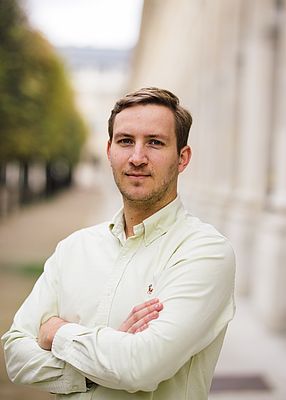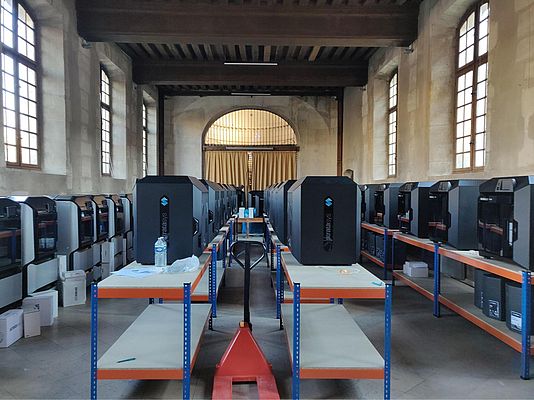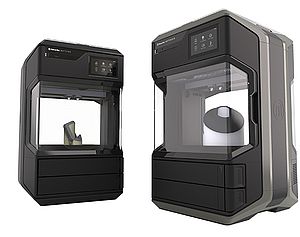Arnaud Toutain is Medical Segment Lead EMEA at the Stratasys office in Baden-Baden. He works in the commercial and business part of the medical sector, closely with manufacturers of medical devices as well as the pharmaceutical industry. Recently, the University Hospital Trust, Assistance Publique – Hôpitaux de Paris (AP-HP) has installed 60 industrial-grade Stratasys FDM 3D printers to create protection equipment to deal with the pandemic.
Stratasys developed FDM (Fused Deposition Modeling) technology over 30 years ago. More recently (2011), the company merged with another company, Objet Ltd., which developed the PolyJet technology. This technology using resin allows larger capacities in terms of printed models. They can be multi-color, multi-material, with more transparency and flexibility. The FDM and PolyJet printers help in the fight against coronavirus by printing medical equipment, and mostly protection equipment.
IEN Europe: Has the coronavirus crisis had any impact on Stratasys’ work management?
A. Toutain: At the Stratasys office in Baden-Baden, we are used to working from home. This changes little for me beyond the fact that I no longer travel for meetings with prospects. Appointments are made virtually via different applications. People that don’t particularly need to go to the office work from home. This working method has been widely implemented at Stratasys.
IEN Europe: What have been the impacts on Stratasys' business activity?
A. T.: In the medical sector it can be difficult to carry out projects with medical device manufacturers, given the uncertainty of the future. Many projects initiated before the crisis are on hold. The discussions will resume around June/July. The business is obviously impacted, but I think that the recovery will be less difficult in the medical sector than in other industries. For instance, some hospital units are reopening for issues other than Covid-19.
IEN Europe: What have you implemented in your sector in response to the crisis?
A. T.: We have implemented a “Covid-19” initiative. Our application engineers work on different 3D models to make them available to our network of customers. The goal is to develop designs that can be easily printed with our machines. We also have at our head office what is called the "Benchmark Center". It is a production center without commercial activity that is used as a support for demonstrations. Since our commercial activity is decreasing because of the crisis, we reassigned the functions of this production center in order to produce parts for hospitals free of charge. Many initiatives have emerged in the Baden-Baden region, in local hospitals around our office. Then we had requests from European hospitals, and we were able to send them the parts.
IEN Europe: What kind of equipment is designed in hospitals?
A. T.: We mainly send protective equipment. From a regulatory point of view, we are now in a more secure position to send these parts. We know that some 3D makers in Europe may print other kinds of equipment. Printing medical devices – like connectors – present more risks as we do not control the supply chain. We do not know under what conditions these devices were produced. It appears very risky for me to use these elements on a respirator in contact with a patient whose life depends on it.
IEN Europe: What medical products can you manufacture using 3D printing?
A. T.: As mentioned before, we can easily print protection equipment, such as face shields or elastic mask holders. What is printed by the users of our machines depends on their qualification and the country's regulations. For instance, the machines in the Cochin hospital print connectors or adapters for diving masks.
IEN Europe: What guarantees can you provide in terms of quality control and certifications?
A. T.: From the hardware point of view, our professional machines are certified and tested in the aeronautical, automotive, railway industries. Therefore, they meet high standards. On the material side, we provide the specifications regarding chemical resistance and mechanical properties. Because of the Covid-19 crisis, we have launched emergency tests on a material that is normally used in dentistry to make medical bridges. We did some tests to determine its impact if we used it to make connectors. The test results were provided to our customers that can print this material using our PolyJet machines. When it comes to medical devices, the certification does not come from the manufacturer of the machine but from the user, who has to make sure that his supply chain is compliant. We provide the tools that allow users to comply.
IEN Europe: In the future, would it be possible to print even more complex medical equipment?
A. T.: Yes, absolutely. Some of our customers among manufacturers of medical devices perform more complex works with our machines. PolyJet technology brings us better capabilities to handle advanced work in terms of geometry. Creating complex elements is feasible but requires a lot of knowledge, especially in regulatory matters. Beginners could imagine and design whatever they want on software and print it as long as they follow the rules. The Cochin Hospital, for example, acquired 60 FDM machines to meet their needs during the crisis and in the future. Until then, the hospital did not have good knowledge of 3D printing. Therefore, it signed a service contract with Bone3D (a start-up located in Paris) which provided all the operational part. Thus, when a surgeon issues a request on the covid3d.org platform, Bone3D - thanks to their knowledge of regulations - is able to decide whether to address this request or not. If the Cochin Hospital would only make protective equipment, it would only have had to find a model on the internet and then print it widely. As requests are more sophisticated, the services of an external service provider allow to manage them better.
IEN Europe: In a context of crisis, can you tell us more about the advantages of additive manufacturing compared to conventional manufacturing?
A. T.: In comparison with injection molding or machining, 3D printing makes it possible to produce locally, which drastically reduces the supply chain. Flexibility is also a big advantage. In injection molding, a new mold for a new part would require a new installation and new tests, while 3D printing allows you to switch from print to print. FDM technology has evolved a lot, especially with professional machines where calibrations are done automatically. It’s a real "click & print".
The Cochin Hospital example shows that 3D printing can be implemented very quickly: the machines were delivered in less than 48 hours. In less than a week, the entire fleet was up and running for devices whose design already existed. Our company is supported worldwide by a network of retailers who take care of the installation, training, and maintenance part. Bone3D has an office in Paris and this enables to speed up the installation and training. Bone3D can operate all the machines remotely - the 60 machines at the AP-HP hospitals are connected to the same software, which delivers a global view of the entire fleet as well as the status of each print.
IEN Europe: In the future, will people use more and more 3D printing and tools?
A. T.: Absolutely. People slightly know it, but 3D printing was already widespread while we were still talking about a not mature enough project. The Covid-19 crisis may accelerate this evangelization, although the benefits of 3D printing in hospitals are already clearly visible. We know that the patient's health benefits from it, and hospitals as well because of the time reduction of each operation which reduces costs.
IEN Europe: Would you like to add something regarding applications of 3D printing in the medical context?
A. T.: Regarding applications, if a part (other than mechanical) breaks in the hospital, we are able to quickly create a temporary part while waiting for the replacement of the part from the original supplier. On a clinical routine, 3D printing can be used to make replicas of the patient or models for surgical planning. The 3D model will help the surgeon plan the operation by making it possible to visualize the pathology. It also constitutes a training before the real operation. In maxillofacial surgery, the surgeon uses plates that act as binders between pieces of bone from a patient who has had an accident. These are straight generic plates that the surgeon needs to fold to conform to the shape of the patient. By adapting these plates directly to the operating room, the operating time is extended, and the patient is longer under anesthesia. While, with a printed replica of the fracture, the surgeon can adapt his plates upstream. The operating room time is therefore reduced, which is beneficial for everyone.
Anis Zenadji




















